  Ursula's
History Web Ursula's
History WebChildhood 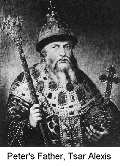 Tsar
Alexis, having lost his first wife in childbirth, took a second wife,
Natalya on February 1, 1671. The joy was great when on May 30, 1672
they became parents of a large, apparently healthy boy. They called him
Peter after the apostle. He was born in the Terem Palace, the royal
residence within the Kremlin, the walled and fortified central area of
Moscow, capital of the Russian State. Peter’s world changed
suddenly when he was not quite four years old. Tsar
Alexis, having lost his first wife in childbirth, took a second wife,
Natalya on February 1, 1671. The joy was great when on May 30, 1672
they became parents of a large, apparently healthy boy. They called him
Peter after the apostle. He was born in the Terem Palace, the royal
residence within the Kremlin, the walled and fortified central area of
Moscow, capital of the Russian State. Peter’s world changed
suddenly when he was not quite four years old. 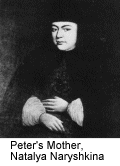 His
father had caught a chill standing on the cold winter air at the annual
event of blessing the waters of the Moscow River. Alexis died on
February 8, 1676, and. his successor was his semi-invalid son Fedor of
his first wife Maria, who reigned briefly as Feodor II. When he died
six years later, Peter was proclaimed Tsar under the Regency of
Peter’s mother Natalya. Peter was then ten years old. Three
weeks later, his scheming half sister Sophia, wanting power for herself
and her side of the family, instigated a palace revolution by the
streltsy in favor of her feeble-minded brother Ivan, who had been
passed over by the succession. His
father had caught a chill standing on the cold winter air at the annual
event of blessing the waters of the Moscow River. Alexis died on
February 8, 1676, and. his successor was his semi-invalid son Fedor of
his first wife Maria, who reigned briefly as Feodor II. When he died
six years later, Peter was proclaimed Tsar under the Regency of
Peter’s mother Natalya. Peter was then ten years old. Three
weeks later, his scheming half sister Sophia, wanting power for herself
and her side of the family, instigated a palace revolution by the
streltsy in favor of her feeble-minded brother Ivan, who had been
passed over by the succession.Peter stood with his mother on the Red staircase leading to the Facets Palace in the Kremlin and watched in sheer terror as his supporters were flung from the top of the staircase to be impaled by the halberds of the guardsmen below. From this time on he hated the sight of this Palace and he never again trusted the streltsy. As a result of this revolt, Ivan was proclaimed co-Ruler with Sophia as Regent. His mother, afraid to stay on in the Kremlin, moved with Peter and his younger sister to a modest estate in the village of Preobrazhensky near Moscow. There, Peter spent the rest of his childhood and early youth, returning to Moscow only on state occasions. Visible from the hilltop estate, about two miles away, lay the German Quarter. There, Peter found men who could teach him things he wanted to know, as he was intelligent and eager for knowledge. From the age of twelve, with the help of skilled craftsmen at the German Quarters he began to learn trades. Peter hired the Dutchman Franz Timmerman as his tutor. One day, as Peter and Timmerman were exploring the outbuildings of one of the Romanov ancestral estates, they came across the decaying hulk of a small sailboat. Another Dutchman, Karsten Brandt, repaired and rigged the boat and showed Peter how to handle it. He took Peter to a large lake some 50 miles from Moscow and taught him how to sail. This was the beginning of his lifelong fascination with ships and the sea. From his earliest childhood Peter loved playing soldier. At Preobrazhensky he called together the sons and grooms of the gentry and then called boys to volunteer from the next village of Semenovsky. He organized his playmates into small armies. He learned to judge people not by their titles, but by their qualities as individuals. By the time Peter was seventeen these play troops became the core of Peter’s army. Then he learned that Sophia wanted him killed. He fled to the monastery of the Holy Trinity-St. Sergius. Some of closest friends found him there and persuaded him to mount a coup against his half sister. When Peter rode in triumph into Moscow, the streets were lined with streltsy, requesting to be pardoned for what they had done seven years before. Peter’s half brother Ivan denounced all claims to the throne and Sophia was sent off to a nunnery for the rest of her life. Peter’s Marriage That year he followed his mother’s wishes and married a girl she had selected for him. Eudokia Lopukhin was a girl of the nobility, young, reasonable pretty, and although she meant well, she lacked spirit and imagination. She didn’t understand Peter’s ideas and they had little in common. After she produced two children, the ill-fated Alexis and another boy Alexander, who died in childhood, Peter had little to do with her. She too went into a convent and Peter eventually he divorced her. Peter’s Visit to Western Europe 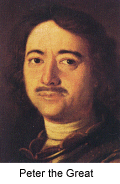 The
first important act of Peter’s reign was a campaign against
the Turkish bastion of Azov. The Turks were still the strongest
military power in the world, and they refused to accept the loss of
Azov. Peter was faced with a long, expensive war, which Russia could
not fight alone. He needed allies; therefore he decided to go incognito
with some of his most trusted advisers to the major capitals of Europe.
He traveled under the name of Peter Mikhail. The group left Moscow on
March 9, 1698. During the eighteen months of travel that took him
through the Swedish Baltic provinces, Prussia and other north German
states, Holland, England, Austria and Saxony, his interest remained
insatiable. He stayed four months in Holland, going through the whole
process of shipbuilding. In England he saw King William III, who
presented Peter with a beautiful twenty-gun yacht. Peter saw English
life and institutions: Parliament, Oxford, the Greenwich observatory,
the arsenal, the mint, and the tower of London and Windsor castle. King
William, however, had no interest in joining to fight the Turks, so
Peter went on to Austria. There too negotiations for help against the
Turks did not succeed. He was preparing to move on to Venice, when a
courier arrived with the message that four regiments of the streltsy
had revolted and were marching on Moscow. Peter left hurriedly for
home. In Poland the message reached him that the revolt had been put
down and the leaders executed. He met King Frederick Augustus of Saxony
and Poland and then went on to Moscow. He arrived in the evening and
went to see his mistress Anna Mons at the German Quarter. He was home
after seventeen months and seventeen days. History records
Peter’s European visit as the Great Embassy. The
first important act of Peter’s reign was a campaign against
the Turkish bastion of Azov. The Turks were still the strongest
military power in the world, and they refused to accept the loss of
Azov. Peter was faced with a long, expensive war, which Russia could
not fight alone. He needed allies; therefore he decided to go incognito
with some of his most trusted advisers to the major capitals of Europe.
He traveled under the name of Peter Mikhail. The group left Moscow on
March 9, 1698. During the eighteen months of travel that took him
through the Swedish Baltic provinces, Prussia and other north German
states, Holland, England, Austria and Saxony, his interest remained
insatiable. He stayed four months in Holland, going through the whole
process of shipbuilding. In England he saw King William III, who
presented Peter with a beautiful twenty-gun yacht. Peter saw English
life and institutions: Parliament, Oxford, the Greenwich observatory,
the arsenal, the mint, and the tower of London and Windsor castle. King
William, however, had no interest in joining to fight the Turks, so
Peter went on to Austria. There too negotiations for help against the
Turks did not succeed. He was preparing to move on to Venice, when a
courier arrived with the message that four regiments of the streltsy
had revolted and were marching on Moscow. Peter left hurriedly for
home. In Poland the message reached him that the revolt had been put
down and the leaders executed. He met King Frederick Augustus of Saxony
and Poland and then went on to Moscow. He arrived in the evening and
went to see his mistress Anna Mons at the German Quarter. He was home
after seventeen months and seventeen days. History records
Peter’s European visit as the Great Embassy.The Rise of St. Petersburg From the Swamps of the Neva 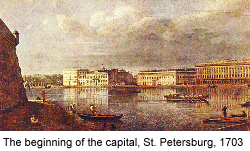 Failing
to assemble an anti-Turkish coalition, Peter had to make peace with the
Turks. He lost Azov and had to put aside temporarily his hopes for
access to the Black Sea. After returning home from the Great Northern
war, where he won a series of victories over the Swedish force, Peter
started work on a fortress and port he named after his patron Saint,
St. Petersburg. It was the unlikely place to build a city. Across the
main branch of the river Neva, facing his fortress, he built his
Admiralty. He had canals dug and he built his first house in St.
Petersburg. It had only three small rooms, bedroom, dining room and
study. It was of pine boards painted on the outside to look like a
little Dutch house. In 1712 he ordered 1000 men of the lesser nobility
to come with their families to St. Petersburg. They were to build
houses there, and a similar order went to 500 merchants and
shopkeepers. The Senate was still in Moscow, when Peter declared his
new city on the river Neva the capital. All Senators were ordered to
leave Moscow and reestablish themselves in St. Petersburg. Three years
earlier Peter had smashed the Swedes in the battle of Poltova, and his
goal was now to make Russia part of Europe. Failing
to assemble an anti-Turkish coalition, Peter had to make peace with the
Turks. He lost Azov and had to put aside temporarily his hopes for
access to the Black Sea. After returning home from the Great Northern
war, where he won a series of victories over the Swedish force, Peter
started work on a fortress and port he named after his patron Saint,
St. Petersburg. It was the unlikely place to build a city. Across the
main branch of the river Neva, facing his fortress, he built his
Admiralty. He had canals dug and he built his first house in St.
Petersburg. It had only three small rooms, bedroom, dining room and
study. It was of pine boards painted on the outside to look like a
little Dutch house. In 1712 he ordered 1000 men of the lesser nobility
to come with their families to St. Petersburg. They were to build
houses there, and a similar order went to 500 merchants and
shopkeepers. The Senate was still in Moscow, when Peter declared his
new city on the river Neva the capital. All Senators were ordered to
leave Moscow and reestablish themselves in St. Petersburg. Three years
earlier Peter had smashed the Swedes in the battle of Poltova, and his
goal was now to make Russia part of Europe.Peter's Second Marriage Almost nothing is certain about Catherine’s origins. She was probably born illegitimately in 1684 or 1685 of Lithuanian peasant stock in the region later called Estonia. Her given name was Martha and she used the family name Skavronskaya. Her mother died when she was three years old, and she grew up in East Prussia with the family of a Lutheran Pastor. During the second Northern War, Marienburg fell to the Russians. Pastor Gluck managed to cross the Russian lines with his family and household. 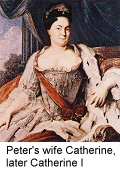 Martha
was then seventeen years of age, a beautiful dark-haired girl with a
fine figure. The Russian Field Marshal Boris Sheremetov saw her and
asked about her. When it was discovered that she was only a servant, he
sent the Gluck family on to Moscow and kept Martha as his housekeeper.
She remained with Sheremetov for the next six months, then Alexander
Menshikov, a close friend of Peter’s from early youth, saw
her and wanted her for himself. Alexander had distinguished himself
during Peter’s military campaigns, and Peter had given him
large estates and the Russian title of Prince of Izhora. Alexander took
Martha to live in the household his own two sisters had kept for him.
Sometime during the next few months she started to call herself
Catherine. Around the year 1703 Peter arrived at Alexander’s
headquarters. That evening he noticed her among the several women who
served at the officer’s table. Some months later after
meeting Catherine, during which he shared her with Alexander, Peter
took her for his own. Martha
was then seventeen years of age, a beautiful dark-haired girl with a
fine figure. The Russian Field Marshal Boris Sheremetov saw her and
asked about her. When it was discovered that she was only a servant, he
sent the Gluck family on to Moscow and kept Martha as his housekeeper.
She remained with Sheremetov for the next six months, then Alexander
Menshikov, a close friend of Peter’s from early youth, saw
her and wanted her for himself. Alexander had distinguished himself
during Peter’s military campaigns, and Peter had given him
large estates and the Russian title of Prince of Izhora. Alexander took
Martha to live in the household his own two sisters had kept for him.
Sometime during the next few months she started to call herself
Catherine. Around the year 1703 Peter arrived at Alexander’s
headquarters. That evening he noticed her among the several women who
served at the officer’s table. Some months later after
meeting Catherine, during which he shared her with Alexander, Peter
took her for his own.Catherine went with him on his military campaigns, showed remarkable courage and was the only one who could calm Peter down when he had one of his rages. When Peter built a winter Palace and a summer Palace, they were for Catherine. After bearing his first child, she was received into the Orthodox Church and formally christened Ekatarina (Catherine.) In 1707 they married in a private ceremony at the Holy Trinity in St. Petersburg, however, Peter did not make his marriage to Catherine public until five years later in February 1712. That spring the summer Palace was finished and they moved in; it was their first home as man and wife. Of five children, only two girls had survived, Anna and Elizabeth, and these two little girls suddenly found themselves elevated to the status of Princess. Peter was absent many times for long periods, fighting against Charles XII of Sweden. When he returned in 1715, Catherine told him that she found a place not far from the city where she thought he might want to live. She led him to the countryside to a point eight miles from the city, where he could see the spires of St.Petersburg in the distance. "Here is the country Palace which I had built for you." Peter was very pleased, and the place became known as the Catherine Palace. The Tsarevich Alexis When Peter forced Alexis' mother into a convent, she kept her son with her. He had various tutors, including some priestly ones. He grew up estranged from his father and married a German Princess and sister-in law of the Austrian Emperor. After his wife died in childbirth, Alexis drifted into idleness. Peter had made many enemies among the nobility with his reforms, and some of these dissidents began to look to Alexis as their leader against Peter and the new Russia he was building. Peter was enraged by Alexis' disinterest in government. In 1715 he wrote his son, and heir, a letter threatening to disinherit him. Alexis in his reply offered to renounce the throne. Peter told Alexis that he would have to retire to a monastery, to diminish the threat of rebellion. 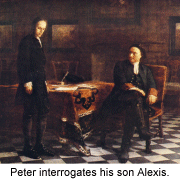 Alexis
suddenly changed his mind. Invited by his father to join him on a trip
to Copenhagen, he fled to his brother-in law in Austria. Peter was
forced to act, as all Europe looked on. Alexis was coaxed back to
Russia with promises of amnesty. In the Cathedral of the Assumption in
Moscow, Alexis publicly renounced his claim to the succession. Just the
same, he was imprisoned in the fortress of St. Peter and Paul on June
24, 1717. On the same day a court of 100 members ordered Alexis
executed for treason. Before this could happen, he was put to torture.
The archives of the fortress tell us: "the rack was applied at eleven
o’clock, and that same day at six o’clock in the
afternoon the Tsarevich gave up his soul." Alexis
suddenly changed his mind. Invited by his father to join him on a trip
to Copenhagen, he fled to his brother-in law in Austria. Peter was
forced to act, as all Europe looked on. Alexis was coaxed back to
Russia with promises of amnesty. In the Cathedral of the Assumption in
Moscow, Alexis publicly renounced his claim to the succession. Just the
same, he was imprisoned in the fortress of St. Peter and Paul on June
24, 1717. On the same day a court of 100 members ordered Alexis
executed for treason. Before this could happen, he was put to torture.
The archives of the fortress tell us: "the rack was applied at eleven
o’clock, and that same day at six o’clock in the
afternoon the Tsarevich gave up his soul."Catherine Crowned The war with Sweden had gone on for years. Finally, Russian victories and tireless diplomacy brought hostilities to an end on August 30, 1721. The following year Peter was declared Emperor of all Russia. Two years later Peter shared his acclaim with Catherine. His declaration said: "Our best beloved spouse, consort and Empress Catherine has been a great support to us…also in many military operations, putting aside her womanly weakness, of her own will she had been present with us and helped in every way possible…and so, for these labors of our spouse, we have decided that by virtue of the supreme power given us by God, she shall be crowned." Peter held the coronation, not in his beloved St.Petersburg, but in the Kremlin in Moscow. The coronation procession began from the Red Staircase. Catherine’s gown and all the dresses and finery for the grand festivities were ordered from France. Her cape was embroidered in gold with the Russian double eagle. Her crown sparkled with precious gems. When the moment came, Peter himself placed the crown on her head. Peter’s Last Years 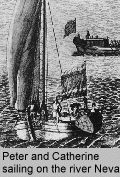 Peter
wanted all people of St. Petersburg to be sailors. He issued an order
that every able-bodied citizen must have a boat. Anyone who could not
afford to buy one would be supported with public funds. All visitors to
the Winter Palace or Summer Palace were asked to arrive by boat. In
1723 Peter brought his own little boat to St. Petersburg. It became
known as the "Grandfather of the Russian Navy." There were many good
times. In the summer many citizens assembled in the harbor on Sundays,
and while orchestras played and vodka flowed, they sailed down the
river led by Peter and Catherine. In November 1724 Peter saw a ship
that had gone aground and was in danger of capsizing. He jumped into
the cold water and helped save the crew, but the exposure to the frigid
water brought him down with a cold. By Christmas he felt well enough,
but then he had a relapse. He died in Catherine’s arms on
January 28, 1725. Peter
wanted all people of St. Petersburg to be sailors. He issued an order
that every able-bodied citizen must have a boat. Anyone who could not
afford to buy one would be supported with public funds. All visitors to
the Winter Palace or Summer Palace were asked to arrive by boat. In
1723 Peter brought his own little boat to St. Petersburg. It became
known as the "Grandfather of the Russian Navy." There were many good
times. In the summer many citizens assembled in the harbor on Sundays,
and while orchestras played and vodka flowed, they sailed down the
river led by Peter and Catherine. In November 1724 Peter saw a ship
that had gone aground and was in danger of capsizing. He jumped into
the cold water and helped save the crew, but the exposure to the frigid
water brought him down with a cold. By Christmas he felt well enough,
but then he had a relapse. He died in Catherine’s arms on
January 28, 1725.The Succession Peter I died without leaving any specific instructions about an heir. In the last hour of his life, he asked for a pen and paper. He started to write, "Give all to …". The next word could not be read. His daughter Anna was called to write down his last wish, but before she could do so, he was unconscious. 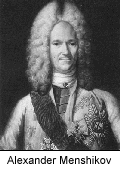 After
Peter's death, Menshikov made some quick maneuvers and hurried to
secure the support of Peter’s two regiments for Catherine.
Grand Admiral Apraxin issued a proclamation on behalf of the Senate,
that Catherine I will be sovereign of all Russia, according to the
desire of Peter II. A former peasant girl became ruler of the largest
empire in the world. She knew that she was not capable of ruling and
left all to Alexander Menshikov. Catherine died two and half years
later. She had named Peter’s grandson Peter Alexeevich as
successor. He was only eleven years old, and Catherine had appointed a
committee of eight as regent. In 1730 Peter II died of smallpox at the
age of not quite fifteen. He had been the last of the male Romanovs,
and he died without issue and without naming a successor. During the
next decade the succession went to the line of Peter’s half
brother Ivan. In November 1741 Peter and Catherine’s daughter
Elizabeth Petrovna staged a Palace coup supported by the Preobrazhensky
regiment, and became Empress and autocrat of all Russia. However,
Elizabeth was not as industrious as her father. Unmarried, she arranged
for her sister Anna’s son to be named her heir. She found a
bride for her nephew from Prussia and named her in honor of her mother.
But it would take twenty- two years of Elizabeth’s reign and
a few months of the rule of her nephew Peter III, before the work of
Peter the Great would be carried on by the
Princess who became Catherine the Great. After
Peter's death, Menshikov made some quick maneuvers and hurried to
secure the support of Peter’s two regiments for Catherine.
Grand Admiral Apraxin issued a proclamation on behalf of the Senate,
that Catherine I will be sovereign of all Russia, according to the
desire of Peter II. A former peasant girl became ruler of the largest
empire in the world. She knew that she was not capable of ruling and
left all to Alexander Menshikov. Catherine died two and half years
later. She had named Peter’s grandson Peter Alexeevich as
successor. He was only eleven years old, and Catherine had appointed a
committee of eight as regent. In 1730 Peter II died of smallpox at the
age of not quite fifteen. He had been the last of the male Romanovs,
and he died without issue and without naming a successor. During the
next decade the succession went to the line of Peter’s half
brother Ivan. In November 1741 Peter and Catherine’s daughter
Elizabeth Petrovna staged a Palace coup supported by the Preobrazhensky
regiment, and became Empress and autocrat of all Russia. However,
Elizabeth was not as industrious as her father. Unmarried, she arranged
for her sister Anna’s son to be named her heir. She found a
bride for her nephew from Prussia and named her in honor of her mother.
But it would take twenty- two years of Elizabeth’s reign and
a few months of the rule of her nephew Peter III, before the work of
Peter the Great would be carried on by the
Princess who became Catherine the Great. References Peter the Great: His Life and World. Massie, Robert K. Ballantine Books, 1980. |
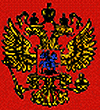
 for more.
for more.